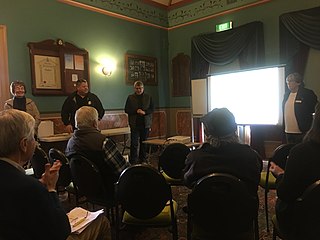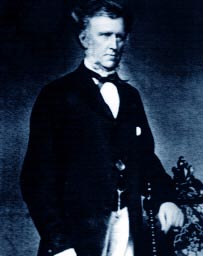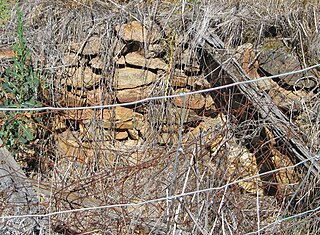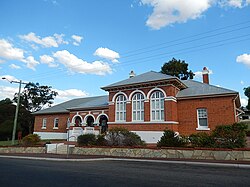William Sykes was an English convict, transported to Western Australia for manslaughter.

The Newcastle Gaol Museum is a prison museum on Clinton Street in Toodyay, Western Australia, founded in 1962. The museum records the history of the serial escapee Moondyne Joe and his imprisonment in the "native cell".

Clackline is a locality in the Wheatbelt region of Western Australia, about 80 kilometres (50 mi) east-north-east of Perth.

Newcastle Hospital in Toodyay, Western Australia was completed in 1894 and was the only purpose-built hospital for the town then known as Newcastle. It ceased operating as a hospital in 1940.

The Toodyay Historical Society started in Toodyay as the Toodyay Society in 1980 in conjunction with the Toodyay Tourist Centre. The first annual general meeting was held at the Country Women's Association hall on Stirling Terrace in April 1981.

The town of Toodyay, Western Australia, was not always known by that name. Initially Toodyay was located in what is now West Toodyay before repeated flooding caused the town centre to migrate to the area around the Newcastle convict depot creating the town of Newcastle. After approximately 50 years of confusion the name of Newcastle was changed to Toodyay and the original Toodyay became known as West Toodyay.

West Toodyay was the original location of the town of Toodyay, Western Australia. It is situated in the Toodyay valley, 85 kilometres (53 mi) north east of Perth. The Toodyay valley, discovered by Ensign Robert Dale in 1831, was opened up for settlement in 1836. The original site for the town of Toodyay was determined in 1836 and its boundaries were finalized 1838. The first survey of the town was carried out in 1849. After several serious floods, the decision was made to move the town of Toodyay to higher ground. In 1860, the new town of Newcastle was established 3 miles (4.8 km) further upstream. Newcastle was renamed in 1910 to Toodyay, and the original site became known as West Toodyay.
Francis Kirk was one of a number of Enrolled Pensioner Guards (EPGs) who came to the Swan River Colony between 1850 and 1868, to guard and oversee the work of the prisoners transported to Western Australia.
David Gailey (1807–1881) was one of a number of Enrolled Pensioner Guards (EPGs) who came to the Swan River Colony between 1850 and 1868. Their role was to guard and oversee the work of the prisoners transported to Western Australia.

The ford crossing is a natural feature of the Avon River in West Toodyay, Western Australia. It was used by the early settlers in the area to cross the river before the construction of the West Toodyay Bridge.

The Toodyay Barracks and its stables, erected in 1842, were the first buildings constructed in the townsite of Toodyay, Western Australia. The Barracks were also the first government buildings within the Toodyay district. Situated on the left bank of the Avon River and a little upstream from the ford, the Barracks overlooked a long pool, which soon became known as the Barracks Pool. In the early 1840s, Toodyay Resident Magistrate John Scully had requested military protection as a means of controlling a problem with the local indigenous people. Governor John Hutt agreed at the time to temporarily station a mounted native policeman to keep order.

The Queen's Head was a hotel in West Toodyay in Western Australia in the latter half of the 19th century.

In 1851, the Toodyay Convict Hiring Depot was set up in the original township of Toodyay, now called West Toodyay. Temporary accommodation for the Enrolled Pensioner Guards was also constructed and surveys were carried out to enable more permanent accommodation to be built close by. The Enrolled Pensioner Guards were men who had either completed their duty of service or who had sustained injury while on active service. They had then volunteered as guards on the ships transporting convicts to Western Australia. Once the men were released from permanent duty, other duties of a peace keeping or military nature were expected of them. Many of these men became warders in charge of convicts.

Toodyay Gaol stood on lot R66, close to the first Convict Hiring Depot, in the original townsite of Toodyay, now known as West Toodyay, in Western Australia. Although generally referred to as a gaol, it was technically a lock-up, holding prisoners only until they were brought before the resident magistrate.

An area in West Toodyay, Western Australia, was gazetted as a Class C Reserve, for water and public utility purposes from 1898 to 1992. A stone-lined well at 31.52281°S 116.42579°E, positioned on what was originally lot R76, exists to this today. It is, however, no longer in use. The well is close to the boundary with what was originally lot R1 on which a spring once arose and flowed into the Avon River. It is very likely that the well had supplied water for a long time, possibly during the 1850s, the days of the convict hiring depot and The Queen's Head hotel.

The Toodyay Valley School was the first government school in Toodyay. It opened on 1 October 1855 with 55 children enrolled. Boarders were received on moderate terms.

The Church of Sancta Maria was the first Roman Catholic church built in the original townsite of Toodyay in Western Australia. It was consecrated in 1859, and served as church, priest's residence, and schoolhouse for the Toodyay Valley Catholic School. It later housed the Toodyay Valley government school.

The Royal Oak established in 1853 by John Herbert was the second inn of that name in West Toodyay. It was also known as Herbert's Hotel. It stood on lot R11, upstream from where the first Royal Oak had been until it closed in November 1851.
Construction of the new Toodyay Convict Hiring Depot began in February 1852 and was completed by 1856. The depot was closed in 1872. The site chosen, Avon Location 110, was an area of Crown land measuring just over 45 acres (18 ha). It was situated approximately 3 miles (4.8 km) upstream from the site of the previous Toodyay Convict Hiring Depot (1851) located at the Toodyay townsite. The previous depot had only ever been a temporary arrangement born of necessity when accommodation was required at short notice. The new depot site was surveyed by Francis Thomas Gregory in 1852.

















